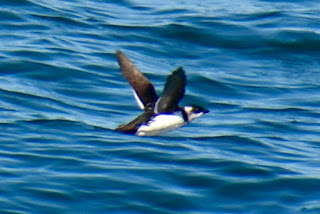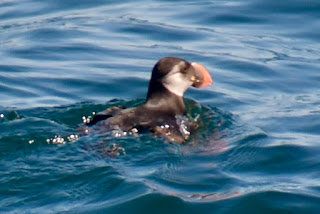Cape May Pelagic - Puffins and Dovekies 2/25/2024
After being back home in New Jersey for a week, I got on the American Princess for a 12-hour pelagic out of Cape May. There is potential for several good winter birds on a February pelagic, some of which are best seen offshore. Alcids, such as razorbills, murres and dovekies, are good bets to find on a pelagic this time of year. Atlantic puffins and northern fulmars can be had the farther out you go. February is also the best chance to come across a great skua. I have seen a good number of razorbills and dovekies already this winter, so my hopes were for murres, puffins, fulmars and kittiwakes. A great skua would be awesome, but while my fingers were crossed, my expectations weren’t high.
The boat left the dock at about 6:30 a.m. and it was cold. I have done several of these trips, so I was prepared. Like the other seasoned winter pelagic birders on board, I planned to be out on the deck for the majority of the 12 hours out on the water. I dressed in layers and was comfortable. By late morning to midafternoon, the weather conditions were not so bad. We weren’t too far from shore when we had a whale sighting. We followed the animal for a while, but never got clear, definitive looks at it. Only part of its back ever broke the surface, and it stayed submerged often while it moved around. The mammal experts on the boat surmised it was a young humpback whale in an atypical feeding style. Razorbill sightings started not far from shore too.
Razorbills. © S. Weiss
Razorbills have longer tails than murres. In flight, the feet of murres extend beyond their tails.
In the 9 o’clock hour the only murre of the day was spotted. It was a common murre and I did not see it. At the time, I was not too concerned that I missed the murre since it was early and there was plenty of time to see others. At the end of the day, when no more murres popped up, I just shrugged it off. I have seen them in NJ before, and I saw dozens of them in Washington state just this past September. We continued to see razorbills but didn’t see our first dovekie until the 10 o’clock hour. We were also entertained in the morning hours by a pod of short-beaked common dolphins swimming around the boat.
By late morning we had reached far enough offshore where the water temperature rose in to the 40-degree range. The warmer water temperature brought an increase in our dovekie sightings. These little alcids, the smallest on the east coast, were being seen inshore earlier in the season. But as the inshore water temperatures dropped as winter progressed, they moved out to warmer water. Over the remainder of the trip, we tallied 237 of these adorable little alcids.
Dovekies. © S. Weiss
Dovekies are the smallest alcids in the Atlantic Ocean. Unlike razorbills and murres, they have dark underwings.
The increase in water temperature also produced our first Atlantic puffin of the trip. Like the first dovekie, the first puffin got everyone excited. Then came a second, and a third puffin. For a good part of the early afternoon, dovekies and puffins were being called out from all directions. The trip total for puffins reached 106. The most I had ever seen previously on one pelagic trip was 34 last February in North Carolina.
Atlantic puffins. © S. Weiss
Puffins are larger than dovekies, but smaller than razorbills and murres. They have dark underwings like dovekies.
There were no kittiwakes around and no fulmars came in to check our chum slick. Apparently, it will likely be another year before I finally find a great skua. Nevertheless, the dovekies and puffins made the trip worth it.
Atlantic puffin and dovekie. © S. Weiss












Comments
Post a Comment